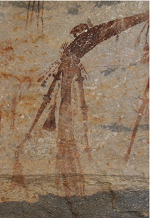Dating Rock Art by Sequencing Microorganisms - A CodonCode Aligner User Showcase

Prof. John D. ("Jack") Pettigrew FRS from the Queensland Brain Institute uses CodonCode Aligner in his studies of ancient rock art from Australia. The Bradshaw rock art depicts extraordinary paintings with very fine lines (a millimeter wide) and human figures adorned with complex decorations. Age and artists of the paintings are unknown but widely speculated. Interestingly the paintings show very high contrast in their colors and did not deteriorate, even though they are assumed to be 30,000 to 70,000 years old.
Recent discovery shows that the Bradshaw rock art is covered with a biofilm containing different microorganisms which is closely linked to the paintings. Prof. Pettigrew says: "The paintings are alive with a mixture of pigmented fungi and bacteria whose replenishment could give a potentially infinite life to the paintings". He aims to use the evolutionary information contained in these microorgansims to determine the age of the ancient rock art. Prof. Pettigrew uses CodonCode Aligner to study an unique fungus from the biofilm and thinks he might be able to solve the controversial problem of the art's age using a phylogenetic tree of fungal DNA.
Analyzing the Biofilm of Living Paintings
Prof. Pettigrew believes that characterizing the microorganisms in the biofilm which covers the paintings could determine the age of each painting. The biofilm contains two important microorganisms that his research focuses on: a black fungus and a red cyanobacterium.


The colors of the paintings are various mixtures of red and black only, and are missing any other colors that artists at that time might have used. The color and intensity of the "paint" is connected to the amount of the black fungus and the red cyanobacterium, a relation that was confirmed by pyrotag sequencing.
Another very striking feature of the paintings is that the biofilm's boundaries are exactly defined by the lines of the painting and do not extend over the paintings borders. They do also not occur on the rock walls around the paintings. This confinement of the biofilm to the outlines of the painting is most likely a result of a direct connection with the painting itself, for example from fungal spores in the original paint. The biofilm may protect the microorganisms from metallic substrates, solar radiation, free radicals, changing water pressure, etc. Since many paintings are etched below the surface of the sandstone, the paint used could also have etched the paintings into the rock, which could have provided an etched niche for the biofilm. Confirmation that the biofilms originated locally and did not disperse would mean that they can be used to date the paintings. To do this, the goal is to use 18s-ITS gene sequences to construct phylogenetic trees. If the organisms are closely connected to their respective paintings, then the trees from paintings in different locations should be independent of each other.
The Biofilm's Black Fungus
Pilot studies were done with pyrotag analysis that identified over 100 different organisms in the biofilm. Prof. Pettigrew decided to focus on the fungus found in the biofilm first, since there is more information available about the mutation rates in eucaryotes (like ITS, SSU) and the fungus seems to be more dominant in the visible biofilm on the paintings.
The newly discovered melanised, rock-adapted fungus is very remarkable since it appears to occupy the base of the fungal phylogenetic tree. With a genome size of only 4 Mb, the fungus has the smallest fungal genome so far described, which indicates that it is even more ancestral phylogenetically than Pneumocyctis (7 Mb - previously the smallest genome). The fungus is unique, with black, spherical spores growing from along the whole length of a hypha. The fungal sequences mapped to the Dothideomyces phylum, in the Capnodiales family.
Black fungus is common in the Kimberley environment where the Bradshaw paintings can be found. There is for example the common fungus in “ink streaks” (black-stained waterfalls and watercourses). Unfortunately the type of relation between this common fungus and the pigmented black fungus found in the rock art is not yet determined. The original paint could have contained anything from a black fungus to tree sap, green tree ants, or pulp from the boab fruit, which would contain organic material and could explain the development of such a biofilm.
Samples from 90 different paintings are presently being sequenced. Jack Pettigrew: "Preliminary analysis of the 200 bp fragments available from the pyrotag analysis of the 18S gene shows that the project is on the right track, with an estimated divergence between these different art sites of 40-130 Kyr (assuming a mutation rate, like many fungi, of 3X10-9 substitutions/site/year). Analysis of 90 more samples from 19 different art sites should enable refinement of these figures as well as a better estimate of mutation rate by comparison with the phylogenetic tree of other Dothideomyces and by examination of the Holocene speed up."
